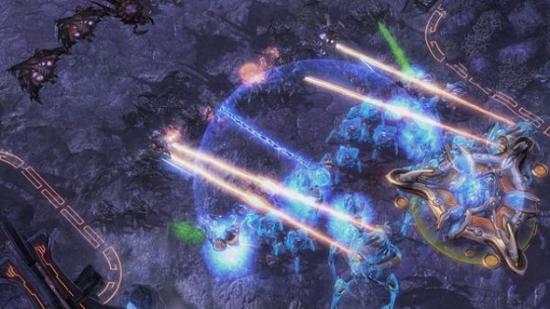Blizzard have embarked upon another broad redesign of StarCraft 2. The focus with this patch is on underused units and abilities, along with some big changes for each faction in multiplayer. The size of the patch means Blizzard are keen to start testing straight away, so it’s already available in the testing section of StarCraft 2 multiplayer, but the final changes won’t be released until the tournament season concludes in November.
Speaking of multiplayer, here are the best multiplayer games on PC.
Affecting everyone are the changes to the economy. The amount of gas in Vespene gas geysers has been increased, along with large mineral nodes, in the hope that it will take a longer time for bases to run out, making it easier for players to make a comeback if they’re denied a third or fourth base.
Each faction has also seen several unit redesigns, and in the case of the Protoss, the removal of the Mothership core.
Terran
After last year’s Mech update, Blizzard are now looking into adjusting MULEs with an eye towards creating a better synergy between them and the Terran Mechs. So MULEs can now mine gas more efficiently, but that diminishes if more than one of them is assigned to a refinery.
Other changes include the Raven becoming a support caster, which means all of its abilities have been replaced by new ones: two new missiles and a deployable, static repair drone. Widow Mines, Liberators, Ghosts, and Cyclones have also been tweaked. Finally, a new upgrade, Smart Servos, will reduce transformation times for the Viking, Thor, Hellion, and Hellbat.
Protoss
Blizzard have been looking into the Protoss’s early game defenses as well as tweaking the splash damage of the High Templar, Colossus, and Disruptor. Possibly the biggest change is the removal of the Mothership Core and the redesign of the Nexus. Chrono Boost will work more like it did during Heart of the Swarm, and two new abilities – Mass Recall and Shield Recharge – have been added to the Nexus, so the Protoss’s defensive power will be concentrated in the Nexus.
Protoss units have been tweaked, too. The Stalker is being positioned as a move-and-fire sniper with increased damage but a slower attack rate; the Disruptor’s getting more consistent damage; the Colossus is being pushed towards an anti-light-armour role; the Carrier’s interceptor cost has been increased; and the High Templar should be easier to use. Finally, the Observer’s new Surveillance Mode ability gives it 25% more vision at the cost of movement.
Zerg
For the Zerg, Blizzard are trying to encourage more interaction with Ceep spread from Zerg specialists while experimenting with ground-based anti-air and, ultimately, want to give them more early and mid-game aggressive options to avoid players feeling like they’re being forced to play defensively.
The Infestor and Lurker are seeing the most dramatic changes with substantial redesigns. The former will interact more with Creep, while Fungal Growth will no longer affect air units, though it will maintain its Area of Effect and root abilities. Infested Terrans will also be more useful, though Blizzard don’t want them to become part of a standard army composition. In regards to the latter, the Lurker Den will be its own building and a new upgrade will allow the Lurker to move and burrow faster. The Viper, Swarm Host, and Overseer are also getting minor changes.
“When making these kinds of changes we start with seeing how the current game is played,” Blizzard tells TeamLiquid.net in a recent interview. “What options does each race have? What do they struggle with? Do they need new tools in any of the matchups? From there we consider what the race identities are and where we can make improvements or nerfs while still preserving how unique each race is.
“We take matchup states into account, but it is hard to predict where the meta will settle in the individual matchups when making so many changes, so we tend to place a greater emphasis making sure each race has enough tools for a variety of situations while still feeling unique.”
Since testing is expected to continue for several months, expect more tweaks and changes before everything is finalised after the tournament season concludes.
